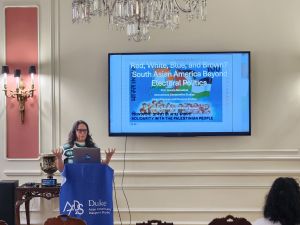The Inscrutability of Sociality and Queer Forms of Asian American Inscrutability

Vivian Huang is an Assistant Professor of Communication Studies at San Francisco State University, specializing in race and performance studies. Their work has been recognized by the Mellon Emerging Faculty Leaders Award, the Hellman Foundation, and the Association of Asian American Studies.
On Feb 16, Huang began the second installment of the AADS Speaker Series, a series that brings attention to new directions in Asian American Studies.
Huang presented a talk titled “Inscrutability of Sociality and Queer Forms of Asian American Inscrutability.” This talk centered around their 2023 book Surface Relations, published by Duke University and the recipient of the Scholars of Color First Book Award. Surface Relations and her conceptualization of the Politics of Inscrutability attempts to “strategically perform Asiatic difference as something that disturbs social conventions and shares alternative ways of being in time, space, and body.”
Huang began their event by addressing accessibility. They offered physical copies of that day’s talk for those who needed it. They integrated bodily needs into the event itself, saying with care, “feel free to move around, stretch, and overall, do what you need to do.”
They then situated the importance of the talk to the current context: liberal multiculturalism. Liberal multiculturalism orients the minority to the nation-state, prioritizing liberal self-hood like representation as the destination for liberation. Huang saw the Asian subject as outside of this, “being inherently inscrutable,” they said. This has personal impacts; if Asian/American history, culture and aesthetics are barely legible in mainstream media, can it even be registered to the Asian/American subject at all?
We can see the limits of liberal multiculturalism through the Harvard Affirmative Action case. Asians were seen as “annoying” and “unlikeable,” being given lower personality scores in admissions. Consequently, when Asians attempt to do the very thing that liberal multiculturalism wants Asians to do, be visible, Asian presence is resented. “Asians are encouraged to take up space but are never supported…or even imagined to do so,” Huang said.
Huang then underscored where Surface Relations engaged with this liberal multiculturalism and its limits to the Asian subject. “[This] book attempts to put together the textures, moods, to focus on a forever blurry image, especially when archives fall short.”
One of the most poignant examples Huang offered was the racialization of masks during the early years of the COVID-19 Pandemic. “The masks depersonalized the face, making the typically inscrutable face even more inscrutable, and that the Asian person is mute.” Masks aesthetically obscured the already inscrutable Asian, producing an inaccessible interiority and passivity on the Asian subject itself. Consequently, the Asian subject was seen as unassimilable, threatening the homogeneity the nation-state so desires. The politics of inscrutability employed here would underscore the serious protective nature of the masks themselves and also make a commentary on the white observer instead of the Asian object it is scrutinizing. It turns the focus back on the white culprit, asking, why even is this scary to you?
Huang ended their talk by highlighting her personal goal with the book: “[I] do this to support minoritized cultural forms, to find each other, to build care networks.”
Numerous questions and comments were raised after Huang’s talk. One member of the audience commented on how “really beautiful [this] talk” was, thanking Huang for surfacing her research. “[It] made me feel less lonely.”
Another audience member asked about the risks of this orientation to art with “What about the repetition of stereotypes in art?” Huang invited the audience member to lean into the liberal multiculturalist impulse in this; what is this repetition and what other utilities can we gain from this approach to art that is not just thinking about the majoritarian?





